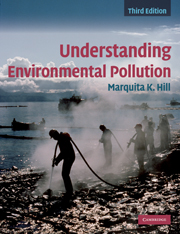Book contents
- Frontmatter
- Contents
- Preface
- Acknowledgements
- List of abbreviations and acronyms
- 1 Understanding pollution
- 2 Reducing risk, reducing pollution
- 3 Chemical toxicity
- 4 Chemical exposures and risk assessment
- 5 Air pollution
- 6 Acid deposition
- 7 Global climate change
- 8 Stratospheric ozone depletion
- 9 Water pollution
- 10 Drinking-water pollution
- 11 Solid waste
- 12 Hazardous waste
- 13 Energy
- 14 Persistent, bioaccumulative, and toxic
- 15 Metals
- 16 Pesticides
- 17 Pollution at home
- 18 Zero waste, zero emissions
- 19 Chemistry: some basic concepts
- Index
- References
15 - Metals
Published online by Cambridge University Press: 05 June 2012
- Frontmatter
- Contents
- Preface
- Acknowledgements
- List of abbreviations and acronyms
- 1 Understanding pollution
- 2 Reducing risk, reducing pollution
- 3 Chemical toxicity
- 4 Chemical exposures and risk assessment
- 5 Air pollution
- 6 Acid deposition
- 7 Global climate change
- 8 Stratospheric ozone depletion
- 9 Water pollution
- 10 Drinking-water pollution
- 11 Solid waste
- 12 Hazardous waste
- 13 Energy
- 14 Persistent, bioaccumulative, and toxic
- 15 Metals
- 16 Pesticides
- 17 Pollution at home
- 18 Zero waste, zero emissions
- 19 Chemistry: some basic concepts
- Index
- References
Summary
“Society is a partnership not only between those who are living, but between those who are living, those who are dead, and those who are to be born.”
Edward Burke, 1790All metals are persistent, but not all fit the other two PBT criteria. ▪ Ability to bioaccumulate limits the list of PBT metals to three: lead, methylmercury, and cadmium. Notice that the element, mercury is not a PBT, but rather methylmercury, which can bioaccumulate in living creatures and biomagnify in the food web a million-fold or more. ▪ Also remember that many metals are nutrients, and that exposure to metal nutrients at normal levels is not toxic. It is the metals that are not nutrients, especially the so-called “heavy” or hazardous metals that can be toxic even at relatively low concentrations. ▪ Another factor in toxicity is the chemistry of the metal's compounds. ▪ The US EPA now has only three metals on its PBT list: mercury, lead, and cadmium. Section I of this chapter is a metal primer, providing information on metals and metal pollution regardless of whether they are PBTs. Section II details the three especially troublesome metal PBTs, lead, mercury, and cadmium plus one metalloid that is not a PBT, arsenic.
A metal primer
Metals are elemental and cannot be chemically destroyed (Chapter 19). But a metal does bond to other elements to become part of a compound. The compounds of a metal show properties different from the parent metal. Consider three examples.
Elemental lead is a solid, but the lead compound, tetraethyl lead an antiknock agent is an oily liquid. The lead is still there, but bonded to carbon in a molecule. The molecule has very different properties than does lead itself.
[…]
- Type
- Chapter
- Information
- Understanding Environmental Pollution , pp. 425 - 455Publisher: Cambridge University PressPrint publication year: 2010



